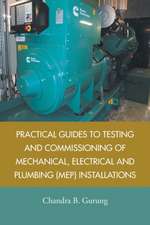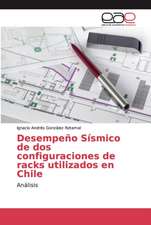Mechanics of Flight 2e
Autor WF Phillipsen Limba Engleză Hardback – 7 dec 2009
Preț: 1029.11 lei
Preț vechi: 1409.73 lei
-27% Nou
Puncte Express: 1544
Preț estimativ în valută:
196.95€ • 204.85$ • 162.59£
196.95€ • 204.85$ • 162.59£
Carte tipărită la comandă
Livrare economică 12-26 aprilie
Preluare comenzi: 021 569.72.76
Specificații
ISBN-13: 9780470539750
ISBN-10: 0470539755
Pagini: 1152
Dimensiuni: 164 x 241 x 49 mm
Greutate: 1.63 kg
Ediția:2nd Edition
Editura: Wiley
Locul publicării:Hoboken, United States
ISBN-10: 0470539755
Pagini: 1152
Dimensiuni: 164 x 241 x 49 mm
Greutate: 1.63 kg
Ediția:2nd Edition
Editura: Wiley
Locul publicării:Hoboken, United States
Public țintă
Mechanical and aerospace engineering students in courses of flight mechanics, aircraft performance, aircraft stability control, or a combined course of aerodynamics mechanics of flight, engineersCuprins
Preface. Acknowledgments. 1. Overview of Aerodynamics. 1.1. Introduction and Notation. 1.2. Fluid Statics and the Atmosphere. 1.3. The Boundary Layer Concept. 1.4. Inviscid Aerodynamics. 1.5. Review of Elementary Potential Flows. 1.6. Incompressible Flow over Airfoils. 1.7. Trailing-Edge Flaps and Section Flap Effectiveness. 1.8. Incompressible Flow over Finite Wings. 1.9. Flow over Multiple Lifting Surfaces. 1.10. Wing Stall and Maximum Lift Coefficient. 1.11. Wing Aerodynamic Center and Pitching Moment. 1.12. Inviscid Compressible Aerodynamics. 1.13. Compressible Subsonic Flow. 1.14. Supersonic Flow. 1.15. Problems. 2. Overview of Propulsion. 2.1. Introduction. 2.2. The Propeller. 2.3. Propeller Blade Theory. 2.4. Propeller Momentum Theory. 2.5. Off-Axis Forces and Moments Developed by a Propeller. 2.6. Turbojet Engines: The Thrust Equation. 2.7. Turbojet Engines: Cycle Analysis. 2.8. The Turbojet Engine with Afterburner. 2.9. Turbofan Engines. 2.10. Concluding Remarks. 2.11. Problems. 3. Aircraft Performance. 3.1. Introduction. 3.2. Thrust Required. 3.3. Power Required. 3.4. Rate of Climb and Power Available. 3.5. Fuel Consumption and Endurance. 3.6. Fuel Consumption and Range. 3.7. Power Failure and Gliding Flight. 3.8. Airspeed, Wing Loading, and Stall. 3.9. The Steady Coordinated Turn. 3.10. Takeoff and Landing Performance. 3.11. Accelerating Climb and Balanced Field Length. 3.12. Problems. 4. Longitudinal Static Stability and Trim. 4.1. Fundamentals of Static Equilibrium and Stability. 4.2. Pitch Stability of a Cambered Wing. 4.3. Simplified Pitch Stability Analysis for a Wing-Tail Combination. 4.4. Stick-Fixed Neutral Point and Static Margin. 4.5. Estimating the Downwash Angle on an Aft Tail. 4.6. Simplified Pitch Stability Analysis for a Wing-Canard Combination. 4.7. Effects of Drag and Vertical Offset. 4.8. Effects of Nonlinearities on the Aerodynamic Center. 4.9. Effect of the Fuselage, Nacelles, and External Stores. 4.10. Contribution of Running Propellers. 4.11. Contribution of Jet Engines. 4.12. Problems. 5. Lateral Static Stability and Trim. 5.1. Introduction. 5.2. Yaw Stability and Trim. 5.3. Estimating the Sidewash Gradient on a Vertical Tail. 5.4. Estimating the Lift Slope for a Vertical Tail. 5.5. Effects of Tail Dihedral on Yaw Stability. 5.6. Roll Stability and Dihedral Effect. 5.7. Roll Control and Trim Requirements. 5.8. The Generalized Small-Angle Lateral Trim Requirements. 5.9. Steady-Heading Sideslip. 5.10. Engine Failure and Minimum-Control Airspeed. 5.11. Longitudinal-Lateral Coupling. 5.12. Control Surface Sign Conventions. 5.13. Problems. 6. Aircraft Controls and Maneuverability. 6.1. Longitudinal Control and Maneuverability. 6.2. Effects of Structural Flexibility. 6.3. Control Force and Trim Tabs. 6.4. Stick-Free Neutral and Maneuver Points. 6.5. Ground Effect, Elevator Sizing, and CG Limits. 6.6. Stall Recovery. 6.7. Lateral Control and Maneuverability. 6.8. Aileron Reversal. 6.9. Other Control Surface Configurations. 6.10. Airplane Spin. 6.11. Problems. 7. Aircraft Equations of Motion. 7.1. Introduction. 7.2. Newton's Second Law for Rigid-Body Dynamics. 7.3. Position and Orientation: The Euler Angle Formulation. 7.4. Rigid-Body 6-DOF Equations of Motion. 7.5. Linearized Equations of Motion. 7.6. Force and Moment Derivatives. 7.7. Nondimensional Linearized Equations of Motion. 7.8. Transformation of Stability Axes. 7.9. Inertial and Gyroscopic Coupling. 7.10. Problems. 8. Linearized Longitudinal Dynamics. 8.1. Fundamentals of Dynamics: Eigenproblems. 8.2. Longitudinal Motion: The Linearized Coupled Equations. 8.3. Short-Period Approximation. 8.4. Long-Period Approximation. 8.5. Pure Pitching Motion. 8.6. Summary. 8.7. Problems. 9. Linearized Lateral Dynamics. 9.1. Introduction. 9.2. Lateral Motion: The Linearized Coupled Equations. 9.3. Roll Approximation. 9.4. Spiral Approximation. 9.5. Dutch Roll Approximation. 9.6. Pure Rolling Motion. 9.7. Pure Yawing Motion. 9.8. Longitudinal-Lateral Coupling. 9.9. Nonlinear Effects. 9.10. Summary. 9.11. Problems. 10. Aircraft Handling Qualities and Control Response. 10.1. Introduction. 10.2. Pilot Opinion. 10.3. Dynamic Handling Quality Prediction. 10.4. Response to Control Inputs. 10.5. Nonlinear Effects and Longitudinal-Lateral Coupling. 10.6. Problems. 11. Aircraft Flight Simulation. 11.1. Introduction. 11.2. Euler Angle Formulations. 11.3. Direction-Cosine Formulation. 11.4. Euler Axis Formulation. 11.5. The Euler-Rodrigues Quaternion Formulation. 11.6. Quaternion Algebra. 11.7. Relations between the Quaternion and Other Attitude Descriptors. 11.8. Applying Rotational Constraints to the Quaternion Formulation. 11.9. Closed-Form Quaternion Solution for Constant Rotation. 11.10. Numerical Integration of the Quaternion Formulation. 11.11. Summary of the Flat-Earth Quaternion Formulation. 11.12. Aircraft Position in Geographic Coordinates. 11.13. Problems. Bibliography. Appendixes. A Standard Atmosphere, SI Units. B Standard Atmosphere, English Units. C Aircraft Moments of Inertia. Nomenclature. Index.
Notă biografică
WARREN F. PHILLIPS, PHD, is a Professor of Mechanical and Aerospace Engineering at Utah State University. Dr. Phillips has more than thirty-five years of experience teaching engineering analysis and design. He has also authored more than sixty scientific journal publications on thermal fluid science, aerodynamics, and flight mechanics.















